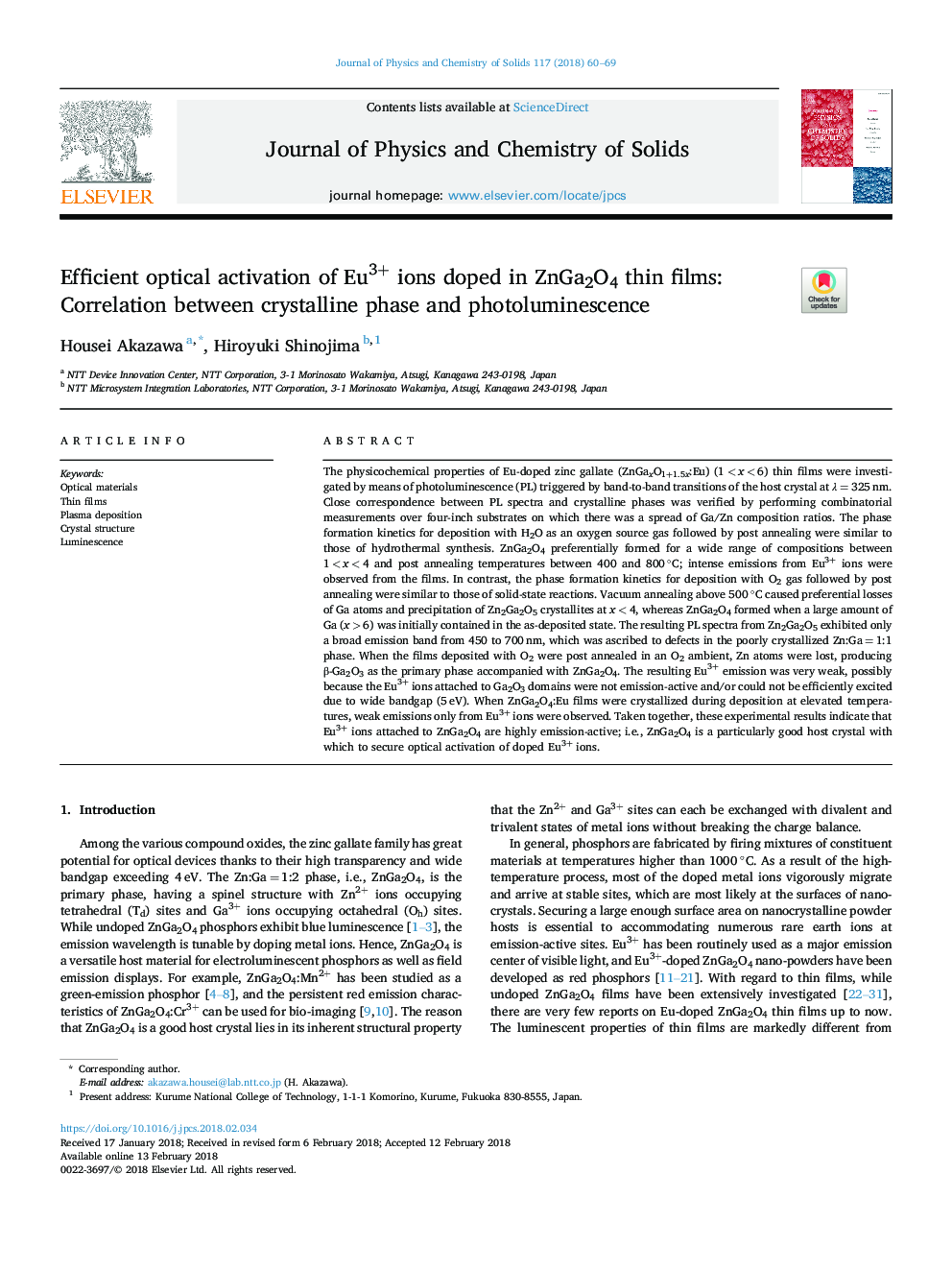| کد مقاله | کد نشریه | سال انتشار | مقاله انگلیسی | نسخه تمام متن |
|---|---|---|---|---|
| 7920253 | 1511489 | 2018 | 10 صفحه PDF | دانلود رایگان |
عنوان انگلیسی مقاله ISI
Efficient optical activation of Eu3+ ions doped in ZnGa2O4 thin films: Correlation between crystalline phase and photoluminescence
دانلود مقاله + سفارش ترجمه
دانلود مقاله ISI انگلیسی
رایگان برای ایرانیان
کلمات کلیدی
موضوعات مرتبط
مهندسی و علوم پایه
مهندسی مواد
مواد الکترونیکی، نوری و مغناطیسی
پیش نمایش صفحه اول مقاله

چکیده انگلیسی
The physicochemical properties of Eu-doped zinc gallate (ZnGaxO1+1.5x:Eu) (1â¯<â¯xâ¯<â¯6) thin films were investigated by means of photoluminescence (PL) triggered by band-to-band transitions of the host crystal at λâ¯=â¯325â¯nm. Close correspondence between PL spectra and crystalline phases was verified by performing combinatorial measurements over four-inch substrates on which there was a spread of Ga/Zn composition ratios. The phase formation kinetics for deposition with H2O as an oxygen source gas followed by post annealing were similar to those of hydrothermal synthesis. ZnGa2O4 preferentially formed for a wide range of compositions between 1â¯<â¯xâ¯<â¯4 and post annealing temperatures between 400 and 800â¯Â°C; intense emissions from Eu3+ ions were observed from the films. In contrast, the phase formation kinetics for deposition with O2 gas followed by post annealing were similar to those of solid-state reactions. Vacuum annealing above 500â¯Â°C caused preferential losses of Ga atoms and precipitation of Zn2Ga2O5 crystallites at xâ¯<â¯4, whereas ZnGa2O4 formed when a large amount of Ga (xâ¯>â¯6) was initially contained in the as-deposited state. The resulting PL spectra from Zn2Ga2O5 exhibited only a broad emission band from 450 to 700â¯nm, which was ascribed to defects in the poorly crystallized Zn:Gaâ¯=â¯1:1 phase. When the films deposited with O2 were post annealed in an O2 ambient, Zn atoms were lost, producing β-Ga2O3 as the primary phase accompanied with ZnGa2O4. The resulting Eu3+ emission was very weak, possibly because the Eu3+ ions attached to Ga2O3 domains were not emission-active and/or could not be efficiently excited due to wide bandgap (5â¯eV). When ZnGa2O4:Eu films were crystallized during deposition at elevated temperatures, weak emissions only from Eu3+ ions were observed. Taken together, these experimental results indicate that Eu3+ ions attached to ZnGa2O4 are highly emission-active; i.e., ZnGa2O4 is a particularly good host crystal with which to secure optical activation of doped Eu3+ ions.
ناشر
Database: Elsevier - ScienceDirect (ساینس دایرکت)
Journal: Journal of Physics and Chemistry of Solids - Volume 117, June 2018, Pages 60-69
Journal: Journal of Physics and Chemistry of Solids - Volume 117, June 2018, Pages 60-69
نویسندگان
Housei Akazawa, Hiroyuki Shinojima,